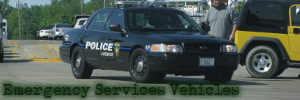















Different Emergency, Different Emergency Vehicle Lights |
|---|

|
Mark Etinger
September 14, 2012
Laws vary widely from state to state, but generally different vehicles use different configurations of emergency vehicle lights depending on the type.
A common philosophical puzzle is as follows: how do I know that when you look at something green, the color you see is the same as the color I see? The implications of this have an analog in the world of emergency vehicle lights. That is, when one person imagines police lights, a clear picture no doubt comes to mind, but necessarily the same image as someone from another part of the country, or even from another part of the state. This discrepancy can be traced to the fact that regulations for emergency vehicle lights are not federally regulated, but in fact vary quite widely from state to state. What different lights mean in different areas can range from compelling to confusing.
Flashing lights may be a guaranteed emergency vehicle in one area, but in another there may be no such guarantees. This is due to the fact that one state may make provisions for some civilians to have certain limited configurations of lights on their vehicle, while other states entirely eliminate the possibility on civilian cars. Whether it's eliminated entirely or not, the limitations (to whatever degree) are intended to curb the overuse of bright lights on the road, the effect of which leads both to confused drivers and the reduced impact of emergency vehicle lights.
In New York State, specific single colors can denote specific vehicles and personnel. Volunteer firemen will employ blue lights. Hatzalah volunteers, an emergency response unit comprised of mostly Jewish volunteers, often use red. EMS volunteers typically use green. Incident Command vehicles use green as well. Confusion is obviously possible in the case of overlapping configurations. As well, none of these are set in stone, but seem to be a cultural habituation. As such, aberrations can occur, potentially leading to more confusion.
Some of the regulations around these emergency vehicle lights can become somewhat extreme. Take one particular law in Arkansas, for example. There, a regular civilian is not allowed to have a blue light, either on or in their vehicle, unless it is firmly held within its original sealed packaging. This no doubt would causes problems for a wandering volunteer fireman from New York, the car's blue light no longer a beacon of intent and purpose, but an illegal signal calling authorities to attention.
The fact of the matter is, whatever the color configurations, and whatever the regulatory issues, signal lights and beacons are an important facet of the emergency response system. What one person sees in this state by different from what someone sees in another, but if the fire gets put out, then the philosophical conundrum loses its meaning.
----------------------------------------------------
http://www.emergencycity.com offers the premier source of emergency vehicle lights, police lights, and numerous other traffice safety products. Between the wonderful customer service and variety of quality products, satisfaction is on the horizon. Visit our blog http://www.lightbarblog.com/ to learn more.
